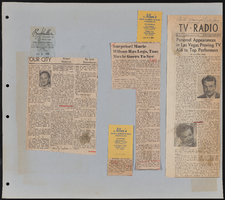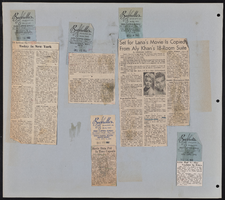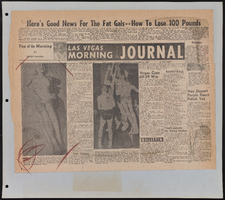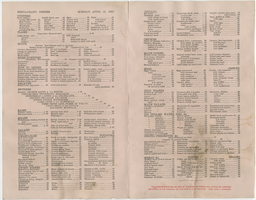Search the Special Collections and Archives Portal
Search Results
Arthur G. Grant Photograph Collection
Identifier
Abstract
Arthur G. Grant Photograph Collection (approximately 1950-1965) consists of 120mm and 35mm color photographic slides taken in the mid-1950s in and around Las Vegas, Nevada. Images depict Arthur G. Grant's home life, the Fortune Club business on Fremont Street, general downtown, Helldorado Parade, and a Mount Charleston picnic. The collection also contains images of Lake Mead boat races including an appearance by Donald Campbell and his water speed world record-setting jet powered boat, Bluebird.
Archival Collection
Desert Fishes Council Records
Identifier
Abstract
The Desert Fishes Council Records (1969-1988) consist of resolutions, meeting minutes, symposium programs, agendas, and press releases of the Desert Fishes Council (DFC). The organization is devoted to the study and preservation of Southwestern desert fishes, notably the desert pupfish. The DFC records reflect efforts to bring the plight of desert fishes to the attention of academics and the public as well as highlight the worth of desert lands within the American environmental movement.
Archival Collection
Las Vegas Women Oral History Project
From the Women's Research Institute of Nevada:
"The Las Vegas Women Oral History Project (LVWOHP) evolved from a collaboration to build a collection of sources on women’s lives in Las Vegas. At the time it began (circa 1994), a critical shortage of information on women’s lives existed in traditional repositories and few oral history projects collected the narratives of women. By 2009, other efforts have taken hold to include women in southern Nevada’s history.
Corporate Body

Gene Noboru Nakanishi oral history interview: transcript
Date
Archival Collection
Description
Oral history interview with Gene Noboru Nakanishi conducted by Ayrton Yamaguchi, Cecilia Winchell, and Stefani Evans on April 2, 2021 for Reflections: The Las Vegas Asian American and Pacific Islander Oral History Project. Gene Nakanishi shares his detailed family history from both his father's and his mother's families. He discusses his paternal grandfather's work on the Union Pacific Railroad, the family's internment in Wyoming during World War II, and his father's release from the camp by joining the United States Army Signal Corps. Nakanishi also talks of his maternal grandfather who was of the Bushido ("warrior") class in Osaka, Japan, and his grandfather's work with Christian missionaries. He shares details of his mother's restaurant employment in Los Angeles and her opening of Osaka Japanese Bistro in Las Vegas in 1969. Nakanishi also talks about being born and raised in Las Vegas, his musical schooling at Berklee College of Music in Boston, and his graduate education at Harvard University. He discusses his work as a band teacher for the Clark County School District, his involvement in the Idyllwild Arts Summer Program band camp, and his interests in jazz music.
Text
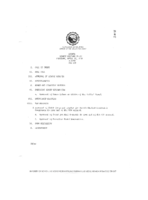
Meeting minutes for Consolidated Student Senate University of Nevada, Las Vegas, April 27, 1989
Date
Archival Collection
Description
Text

Transcript of interview with Roberta Kane by Barbara Tabach, September 6, 2017 and May 22, 2018
Date
Archival Collection
Description
Roberta “Bobbie” Kane (1932 - ) is the first known Jewish child born in Las Vegas. Her parents, Sallie and Mike Gordon, were liquor stores owners and among the founders of the first Jewish congregation in Las Vegas. Bobbie’s childhood remembrances are as a young girl who was fully aware that “Friday nights were reserved for religious services. Saturdays were always reserved for gin rummy.” In the late 1940s, as a teenager at Las Vegas High School (and 1950 graduate), Bobbie recalls Las Vegas as a small town and a joyful place to grow up. She briefly attended University of Southern California before marrying and beginning her family. In time, life brought her back to live with her parents. She pursued a career working for the Desert Inn group of hotels and helped open the Stardust in 1957. She was mentored by Mark Swain, “a six foot-four hunk of a cowboy” who worked for Moe Dalitz. This experience included driving Mark’s pink Cadillac to pick up hotel guests. This provided her with a
Text

